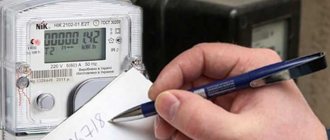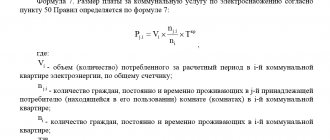An electric meter is a device that needs to be changed in a timely manner, since an error in the readings can lead to excessive payments for electricity. The installation (replacement) of the meter must be carried out by a specialized organization after concluding an agreement with the customer. After the work is completed, the specialist draws up an act for replacing the electric meter. We will look at what is indicated in it in the article.
- Form and sample
- Free download
- Online viewing
- Expert tested
FILES
How to replace an electricity meter in an organization
If the electric meter can no longer be used: a breakdown has occurred or its service life has expired, then it must be replaced. This applies to both residential premises and offices, enterprises, etc. The service life of the devices is indicated in the documentation for them. Typically for an electric meter this period can be up to 25 years.
The procedure for replacing the device will be as follows:
- The company must submit an application to the organization that replaces the meter.
- An engineer goes to the place where the device is being replaced to inspect the site, coordinate actions, calculate the cost and, ultimately, conclude a contract. The contract can be concluded either by the head of the company or by his authorized representative.
- Purchasing the necessary meter. This procedure can be entrusted to an employee who is in charge of the administrative and economic part.
- On the appointed day, a specialist arrives, does his job, changes the electric meter, and seals it.
Under what conditions is the meter changed at the expense of the energy supplier?
Replacing and servicing the meter is free of charge for the user if:
- The meter has expired and must be replaced as planned.
- During the verification process, it was discovered that the device distorts the readings, which makes its further operation impossible.
- The device was damaged due to the fault of the resource supply organization. For example, due to voltage imbalance.
Regardless of the reason for replacing the meter, in most cases the subscriber must independently submit an application for installation of the device. The only exceptions are scheduled work carried out by specialists without notifying the user.
How to fill out an electric meter replacement certificate
The act of replacing the electric meter is drawn up in free form. Companies that are engaged in changing electric meters and other similar work have their own form and sample of such a document. It already contains all the necessary data.
An engineer from the company that services the electrical equipment is responsible for filling out the report form.
The act must indicate the following information:
- The name of the company that replaces the meter.
- Number and date of issue of the license for the right to engage in such activities.
- Title of the document.
- Place and date of formation of the act.
- Name of the organization ordering the service, its address, other details.
- Meter replacement location. Here they indicate the address and name of the premises where the specialist replaced the electric meter.
- Information about the old meter: its type, year of manufacture, serial number. It is imperative to record its readings at the time of dismantling.
- Information about the installed meter: type, production date, serial number. You also need to indicate the readings for the date of installation.
At the end of the document, the engineer who replaced the electric meter signs.
Important! The act must be drawn up in two copies. One is given to the company to the customer, and the second is taken by the contractor.
Legal regulation
In general, issues related to the installation, replacement, testing and operation of electric meters are regulated by Decree No. 354 of the Government of the Russian Federation of May 6, 2011. The said Resolution introduced the Rules for the provision of utility services to residents of apartment buildings and residential buildings.
Over time, the Rules have been repeatedly amended and supplemented. Thus, in accordance with Decree No. 2184 of the Government of the Russian Federation dated December 21, 2020, the following were determined:
- timing of replacement of individual electricity metering devices subject to regular verification;
- the obligation of the electricity supplier to read the negative difference between the total volume of electricity consumed by an apartment building and the volume that was consumed apartment by apartment and each non-residential premises;
- procedure for installation, connection and transfer from the developer to the guaranteeing supplier of electricity meters in newly constructed residential buildings;
- procedure and timing for replacing electric meters in old buildings (old housing stock).
Is it possible to correct errors in the act?
It happens that the engineer filling out the report form makes factual errors: for example, he writes the wrong meter number, date or address. Then you can correct the shortcomings by applying the standard procedure:
- The fragment with an error is crossed out with one line.
- The correct option is written above or next to it in the margin.
- They also write: “Believe the corrected.”
- The corrections made are endorsed with a signature and date.
Corrections must be made with a representative of the customer company.
Guarantee supplier and network organization. What is the difference
In accordance with the latest changes, which we discussed above, replacement of meters can be carried out either by guaranteeing suppliers or by network organizations.
In accordance with the provisions of the Law of the Russian Federation “On Electricity”, business entities that, by law or by virtue of voluntarily accepted obligations, enter into an electricity supply agreement with any person wishing to purchase electricity and living in a certain territory served by the guaranteeing supplier are considered as a supplier of last resort.
As for network organizations, the law considers them to be organizations through whose equipment the supplier of last resort supplies electricity to end consumers.
To put it in the most exaggerated terms, a supplier of last resort is an enterprise that provides electricity and receives payment for it, and network organizations are the owners of electric poles, wires and transformer boxes through which electricity from the supplier of last resort comes to every socket and switch.
Types of electricity control control checks
There are two types of meter checks: primary and periodic. The metering device undergoes initial verification at the manufacturer before installation and use for its intended purpose.
Periodic inspection is carried out until the end of the prescribed revision interval. An extraordinary check of the electricity meter may also be scheduled. It is carried out if:
- there is no document confirming the periodic inspection;
- there is a confirmed need to configure such a counter;
- There was a need to install a new meter.
Inspection intervals may vary for different types of instruments. Also, the frequency of the audit may be affected by various emergency situations.
Electricity metering can only be carried out using a meter that has a product passport or a certificate confirming its compliance with current standards.
Carrying out inspections of metering devices is the responsibility of special organizations. You can call a specialist from such an organization to your home. If this option does not seem reliable enough to you, take the meter to a special organization. After checking the measuring device, you will be given an inspection report.
What the RA needs to know about the installation of common house metering devices
171594
Laboratory testing of PU
Checking metering devices in the laboratory consists of several stages:
1. External inspection.
External inspection allows you to identify mechanical deformations of the meter body or elements. At this stage, the presence of a personal PU number, its configuration or labeling is checked. All elements must comply with current state standards.
2. Checking the insulating elements.
Such a check may not be carried out in relation to new meters, as well as those PUs that have been serviced by a specialized organization where the strength of the insulating elements was tested. Also, verification can be avoided if it is established that the seal is intact, confirming the integrity of the insulation.
3. Testing and checking the correct functioning of the counting mechanism.
At this stage, the device is connected to the mains and warmed up for a quarter of an hour. The power transmission mode and voltage must be within the minimum values. The counter can be monitored by measuring the frequency indicator of disk rotation.
4. Confirmation of the absence of a self-propelled vehicle.
For such a test, electricity is transmitted through a parallel circuit with a voltage of 115% of the rated voltage. The procedure takes place in the absence of voltage in the series connection at the rated voltage of the power source and auxiliary electrical circuits. The duration of the study is 600 seconds. Such a check is not carried out in relation to devices whose design features exclude the possibility of self-propulsion.
5. Checking the sensitivity threshold.
For 600 seconds against the background of the rated voltage of the electrical circuit parallel to the meter and the source of electricity.
At the same time, the relative and basic error of the meter is monitored to ensure compliance with the values provided by the developers. To establish the error, voltage and current meters and a stopwatch are used.
If the study shows that the meter does not meet any parameters, it must be replaced.
When does an individual metering device begin to operate?
142182
Payment for electricity when replacing a meter
So, the law provides guaranteeing suppliers and network organizations with a six-month period for taking action to replace the meter, regardless of the reasons for this replacement.
Payment for electricity consumed during these six months is carried out based on the following calculation. The sum of all consumption according to the meter for the last six months is divided into six months, and payment is made according to the arithmetic average.
In accordance with the provisions of Decree No. 354 of the Government of the Russian Federation dated May 6, 2011, violation of the terms of meter replacement by the guaranteeing supplier or network organization entails a reduction in payment for electricity. So:
- a delay of one to four months will be grounds for a payment reduction of 20% for each month;
- a delay exceeding 4 months is grounds for a 40% reduction in payment.
In case of violation of the replacement period, the end consumer has the right to submit a claim for electricity and demand a reduction in payment. We draw the attention of our readers to this point. There will be no reduction in payment if a claim has not been submitted.
End consumers represented by enterprises and organizations have the right to demand payment of a penalty for violating the deadline for replacing the meter according to the following schedule:
- the first three months from the date of missing the deadline - 50% of the arithmetic average cost of consumption for the month;
- 100% of the arithmetic average cost of consumption for the month starting from the fourth month of delay.
Types of installed energy meters
Modern devices for individual metering of electricity consumption can be classified according to the following characteristics:
- according to the type of current consumed. It can be constant or variable;
- by number of phases. According to this parameter, the meter can be single-phase or three-phase;
- according to tariffs. The electricity meter can be single-tariff, in which case a single cost per kilowatt is used in the calculation, or multi-tariff, when the cost per kilowatt depends on the time of day. In the second case, the device can be two-tariff (day/night) or three-tariff (the day is divided into three periods), for each interval its own payment is established;
- by type of mechanism. Depending on this parameter, the counter can be mechanical or electronic.
Electronic meters are the most common because they are easy to use. GOST on them is constantly updated, so purchasing such a device is not difficult. Mechanical counters are still used, but are gradually being replaced by more modern models.
Installing a meter for several tariffs is not available in all regions of the country.
Stages of checking electricity meters at home
The first thing people pay attention to when checking an electricity meter is that it is connected correctly. Using a visual inspection, the meter is checked for the absence of additional connections and connection failures.
Unaccounted for electricity consumption may be indicated by:
- the presence of holes in the meter that are not provided by the manufacturer;
- violations in the fastening of the glass of the metering device;
- presence of an unintended connection;
- presence of a loose connection screw.
Any of these signs indicates that the rules for using the meter are being violated and electricity is being used illegally.
At the next stage, the inspector calculates the self-propelled vehicle. The term “self-propelled” is used to refer to situations in which the disk of the metering device rotates without load.
Then the gear ratio of the metering device is checked. The gear ratio refers to the number of times the disk rotates or the electronic indicator blinks when one kilowatt of energy is consumed.
The next stage is to identify the measurement error of the metering device. It is carried out in one of three ways:
- current clamps;
- multimer;
- electrical appliance.
If checking the meter reveals a measurement error of more than 10%, the device will have to be replaced.
The last thing you need to do when checking the drive is to determine its magnetization, since under certain conditions the magnetic field can not only slow down, but also accelerate the disk, which will increase the size of the bills for consumed electricity.
On the issue of installing metering devices in apartment buildings
142860
Replacement of the IPU must be carried out after notifying the executor of the control system and in the presence of his representative
The legislation has addressed the issue of unauthorized interference in the operation of a meter, but in practice, suppliers of utility resources cannot always correctly interpret the actions of consumers in relation to IPU without the help of a court. Let's look at an example.
Primorye's electricity supplier went to court. He demanded to collect from the resident of the house the debt for the resource, calculated on the basis of an act of unaccounted consumption, in the amount of almost 60 thousand rubles. Such an act was drawn up because the consumer independently, without notifying the service provider, dismantled the old IPU and installed a new one. The defendant asked the electricity supplier to seal the meter.
Specialists came to the consumer and recorded the fact of interference with the operation of the meter. They also indicated that the resident of the house did not keep the old meter and installed a new one not on the border of the balance sheet of the networks. The consumer did not sign the drafted act and did not pay for the volume of unaccounted consumption calculated based on it, which is why the dispute went to court.
The plaintiff considered that the owner violated clause 81(13) of Regulation No. 354. In the event of a meter failure, he was obliged to immediately notify the service provider, report the IPU readings at that time and arrange for its replacement within 30 days. To dismantle a faulty meter, the consumer must notify the utility contractor of the date and time of such work at least 2 working days in advance. The replacement of the IPU is carried out in the presence of representatives of the service provider.
The owner explained in court that he contacted the service provider with the question of replacing the IPU and wrote a statement. The company representatives who came to him did not replace it, considering that the meter was not on the balance sheet line. Then the consumer himself replaced the IPU and asked the service provider to seal it. He regularly paid the receipts issued to him with the calculation of the fee on average, and then according to the standard, so he has no debt for electricity.
The court of first instance sided with the consumer. He indicated that in this case the utility service provider was obliged to apply paragraphs. “d” clause 59 of Rules No. 354: in the event of failure of the IPU, the calculation of fees for the resource should be based on the calculated average monthly volume of consumption determined according to the indications.
From the date of expiration of the electrical energy metering device, the parties to the energy supply agreement must use the calculation method for determining the payment for the consumed resource. The court did not find in the case any signs of non-contractual consumption or interference in the work of the IPU. The judge refused to allow the supplier to collect the debt from the owner.
How to distinguish unaccounted resource consumption from non-contractual consumption
90871











